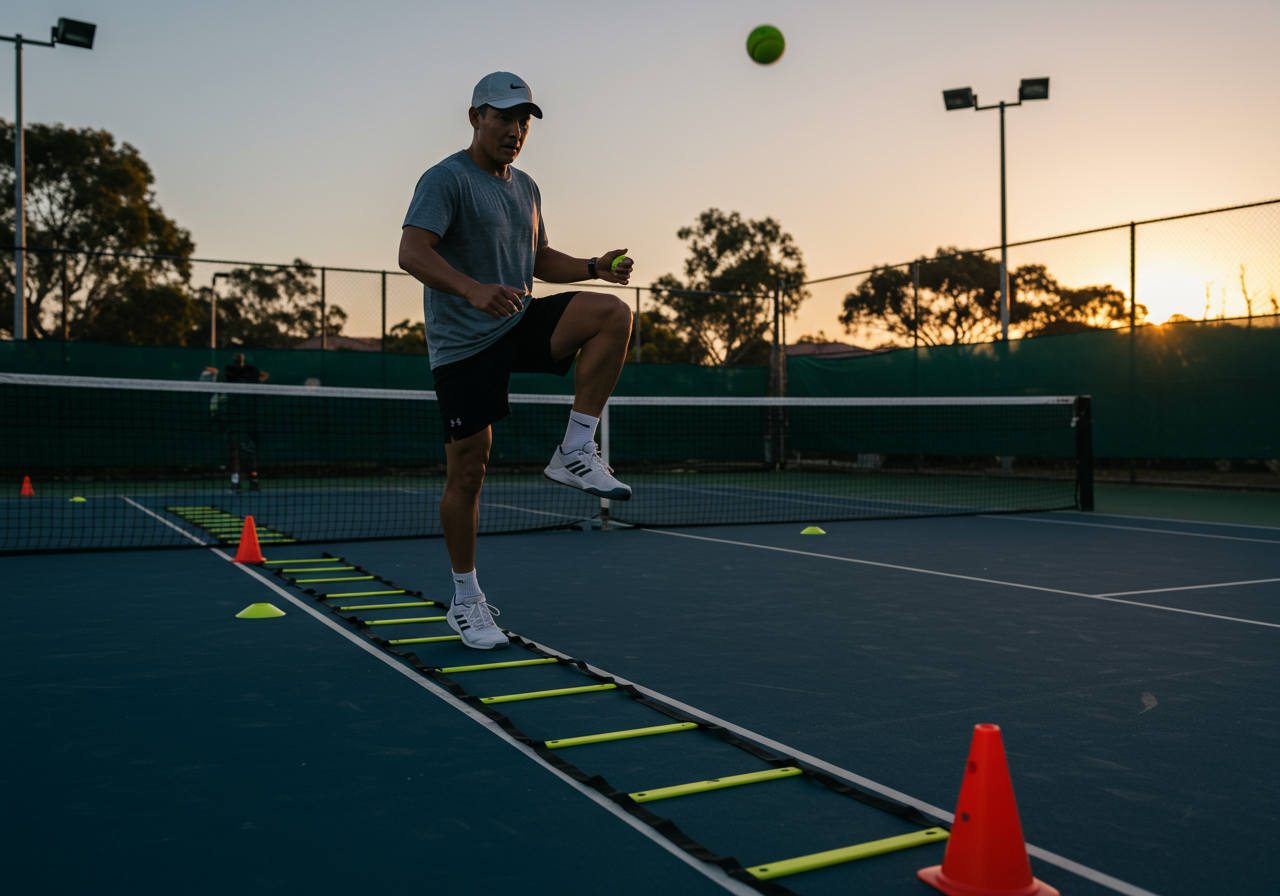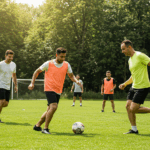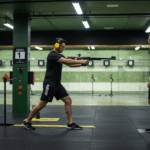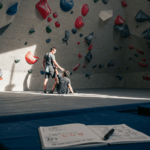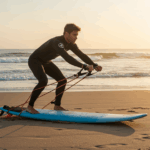Court-First Tennis System: Skills, Strength, and Stamina

Court-First Tennis System: Skills, Strength, and Stamina
This system builds tennis skill and whole-body fitness together. I designed it for beginners. However, it scales up fast.
We train stroke mechanics, footwork, strength, and cardio in one plan. This mix delivers faster improvement. Additionally, it keeps training fun.
| Component | Focus | Dose per Week | Outcome |
|---|---|---|---|
| On-court Skills | Serve, groundstrokes, volleys | 2–4 sessions | Technique, accuracy, confidence |
| Footwork and Agility | Split step, first step, recovery | 2 sessions | Speed and court coverage |
| Strength | Hips, core, shoulders | 2–3 sessions | Power and resilience |
| Aerobic Base | Zone 2 conditioning | 1–2 sessions | Recovery between points |
| Mobility | Hips, T-spine, ankles | Daily micro work | Range and injury defense |
I coach from court data, not guesses. I use a Garmin watch to track heart rate. I also log drills and sets.
My last 75-minute session averaged 142 bpm in Zone 2–3. Peaks hit 176 bpm during point play. Rallies felt crisp.
- 5 minutes mini-tennis in service boxes.
- 5 minutes cross-court rally to targets.
- 5 minutes footwork ladder: in-in-out, 2×20 seconds.
- 5 minutes serves: 20 balls to deuce T, aim 70% in.
Strength supports healthy strokes. I favor hip-dominant lifts and anti-rotation core. Additionally, I train the rotator cuff.
| Exercise | Sets x Reps | Rest | Note |
|---|---|---|---|
| Goblet Squat | 3 x 8 | 90 sec | Heels heavy, knees track toes |
| Romanian Deadlift | 3 x 8 | 90 sec | Hinge, lats on |
| Half-Kneel Pallof Press | 3 x 10/side | 60 sec | Resist rotation |
| Band External Rotation | 3 x 12 | 45 sec | Elbow by side |
Integrated Weekly Plan: Tennis, Cardio, and Strength

Integrated Weekly Plan: Tennis, Cardio, and Strength
This plan balances skills, endurance, and recovery. I keep workloads honest for beginners. However, it scales with data.
| Day | Session | Details | Heart Rate |
|---|---|---|---|
| Mon | Skills + Footwork | 60 min drilling, 15 min ladder, 10 min serves | Mostly Zone 2–3 |
| Tue | Strength A | Goblet squat, RDL, pull-aparts, core | Low HR |
| Wed | Aerobic Base | 30–40 min brisk walk or cycle | Zone 2 |
| Thu | Match Play Light | 45–60 min, short sets, focus on placement | Zone 3 spikes |
| Fri | Strength B | Split squat, cable row, landmine press, cuff work | Low HR |
| Sat | Intervals On-Court | 8–12 x 15 sec live ball, 30 sec rest | Zone 4–5 peaks |
| Sun | Recovery | Mobility 15 min, easy walk 20 min | Zone 1–2 |
- Warm-up: 5 minutes dynamic moves.
- Blocks: 2 x 6 reps of 15 seconds rally, 30 seconds rest.
- Target: Keep form and footwork sharp each rep.
- Cooldown: 5 minutes walking and breaths.
I track sessions on Garmin Connect. I also log notes in Strava. The pairing shows heart rate and drills together.
Beginner to Advanced: Clear Steps and Measurable Progress

Beginner to Advanced: Clear Steps and Measurable Progress
Progress must be obvious and trackable. I use simple checkpoints. Additionally, I advance only after consistency.
| Level | Skills | Fitness Markers | Advance When |
|---|---|---|---|
| Beginner | Rally 10 balls mini-court, 60% serve in | Walk 30 min Zone 2 | 2 weeks consistent, RPE ≤ 6 |
| Early Intermediate | Rally 8 balls full court, aim targets | 6 x 15s on, 30s off, hold form | Serve 65% in, no pain |
| Intermediate | Directional control, swing volley intro | 10 x 15s on, 30s off, even pace | Win 1 set weekly, steady HR |
| Advanced | Pattern play, second serve kick | Yo-Yo IR1 +10% from baseline | Injury-free 6 weeks |
- 5 minutes dynamic warm-up.
- 10 minutes mini-tennis, forehand and backhand.
- 5 minutes cone shuffle, 6 x 10 seconds.
- 10 minutes serves, aim deep middle.
Intermediate players need more structure. I use zones and targets. However, I still protect recovery.
| Block | Duration | Goal | Note |
|---|---|---|---|
| Serve +1 pattern | 15 min | Deuce wide, attack open court | Track serve in% |
| Live ball 2 on 1 | 12 min | Defend, recover center | Zone 4 spikes |
| Strength tri-set | 15 min | Lower, push, core | RPE 7–8 |
Advanced athletes refine tactics and power. I cycle heavy strength and speed. Additionally, I track serve speed.
Fuel, Recovery, and Injury Shields

Fuel, Recovery, and Injury Shields
Recovery determines progress. I learned this after a calf strain from cold starts. Now I warm up well.
Use simple nutrition rules. Additionally, hydrate with intention. Your energy will stabilize.
| Goal | Daily Target | Timing Tip |
|---|---|---|
| Calories | Bodyweight x 30–33 kcal | Cut 300–500 kcal for fat loss |
| Protein | 1.6–2.2 g/kg | Include 20–40 g post session |
| Carbs | 3–6 g/kg training days | Sip during long matches |
| Fats | 0.8–1.0 g/kg | Keep fiber moderate pre play |
| Hydration | 30–35 ml/kg + 0.5–1 L/hour heat | 300–600 mg sodium per hour |
I track intake with MyFitnessPal for new clients. The app simplifies calorie trends and macros.
- 2 minutes brisk walk around the court.
- 4 minutes mobility: ankle rocks, hip openers.
- 4 minutes activation: band walks, scap pulls.
- 5 minutes shadow swings and split steps.
| Issue | Fix | Metric |
|---|---|---|
| Plateau | Swap one session for intervals | VO2 max trend |
| Overtraining | Cut volume 30% for 7 days | Morning HR |
| Motivation dip | Add doubles or new drill | RPE after session |
Sleep anchors recovery. Aim for 7–9 hours nightly. Additionally, keep a steady bedtime.
Proof of Progress: Data, Case Studies, and long-term result interpretation

Proof of Progress: Data, Case Studies, and long-term result interpretation
Results must show in data and feel. I track both in every block. Clients appreciate clear wins.
- VO2 max increased by ~8% via Garmin estimates.
- Resting heart rate dropped from 58 to 53 bpm.
- Serve in percentage rose from 62% to 71%.
- Body mass moved from 82.5 kg to 80.9 kg.
I logged drills in Strava and Garmin Connect. The combined notes showed why improvements happened. Intervals worked.
- Week 1: Walks only, 2 x 25 minutes, Zone 2.
- Week 6: 2 rallies of 12 balls full court.
- VO2 max estimate up 6%. Energy improved at work.
- Quote: “I now finish sets without gasping.”
Client Marcus, 29, played casual doubles. We added structure and data. He liked speed.
- After 8 weeks: Yo-Yo IR1 up 12% from baseline.
- Second serve improved to 68% in from 55%.
- Deadlift moved from 80 kg x 5 to 110 kg x 5.
- Quote: “My legs feel springy in third sets.”
| Method | Use | Outcome |
|---|---|---|
| HIIT Intervals | 8–12 x 15s, 30s rest | Better fat loss and match stamina |
| Steady Zone 2 | 30–45 min, weekly | Better recovery, lower RPE next day |
Track food when goals stall. I use MyFitnessPal for accuracy. It keeps portion sizes honest.
Use official tools for clean data and syncing:
- Garmin for heart rate and VO2 trends.
- MyFitnessPal for calorie and macro tracking.
Maintain progress by cycling stress. Use three hard weeks and one lighter week. Your body will adapt better.
This framework integrates skill, strength, and energy systems. It scales from new players to competitors. Your tennis will feel smooth and powerful.
